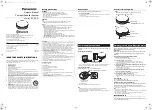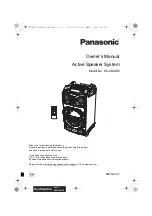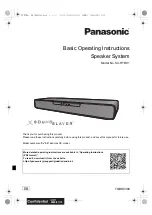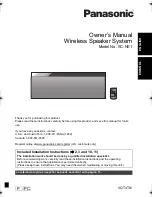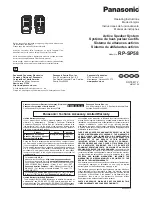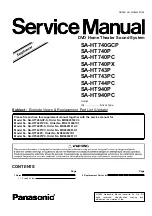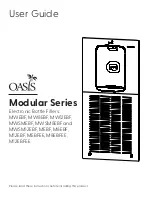
1-4
SERVICING PRECAUTIONS
CAUTION: Before servicing the BD-HTS covered by this ser-
vice data and its supplements and addends, read and follow
the SAFETY PRECAUTIONS.
NOTE: if unforeseen circumstances create conflict between
the following servicing precautions and any of the safety
precautions in this publications, always follow the safety pre-
cautions.
Remember Safety First :
General Servicing Precautions
1. Always unplug the BD-HTS AC power cord from the AC
power source before:
(1)
Removing or reinstalling any component, circuit board,
module, or any other assembly.
(2)
Disconnecting or reconnecting any internal electrical
plug or other electrical connection.
(3)
Connecting a test substitute in parallel with an electro-
lytic capacitor.
Caution
: A wrong part substitution or incorrect polar-
ity installation of electrolytic capacitors may result in an
explosion hazard.
2. Do not spray chemicals on or near this BD-HTS or any of its
assemblies.
3. Unless specified otherwise in this service data, clean elec-
trical contacts by applying an appropriate contact cleaning
solution to the contacts with a pipe cleaner, cotton-tipped
swab, or comparable soft applicator.
Unless specified otherwise in this service data, lubrication of
contacts is not required.
4. Do not defeat any plug/socket B+ voltage interlocks with
whitch instruments covered by this service manual might be
equipped.
5. Do not apply AC power to this BD-HTS and / or any of its
electrical assemblies unless all solidstate device heat sinks
are correctly installed.
6. Always connect the test instrument ground lead to an
appropriate ground before connecting the test instrument
positive lead. Always remove the test instrument ground
lead last.
Insulation Checking Procedure
Disconnect the attachment plug from the AC outlet and turn
the power on. Connect an insulation resistance meter (500V)
to the blades of the attachment plug. The insulation resistance
between each blade of the attachment plug and accessible
conductive parts (Note 1) should be more than 1Mohm.
Note 1
: Accessible Conductive Parts include Metal panels,
Input terminals, Earphone jacks,etc.
Electrostatically Sensitive (ES) Devices
Some semiconductor (solid state) devices can be damaged
easily by static electricity. Such components commonly are
called Electrostatically Sensitive (ES) Devices. Examples of
typical ES devices are integrated circuits and some field effect
transistors and semiconductor chip components.
The following techniques should be used to help reduce the
incidence of component damage caused by static electricity.
1. Immediately before handling any semiconductor compo-
nent or semiconductor-equipped assembly, drain off any
electrostatic charge on your body by touching a known
earth ground. Alternatively, obtain and wear a commercially
available discharging wrist strap device, which should be
removed for potential shock reasons prior to applying power
to the unit under test.
2. After removing an electrical assembly equipped with ES
devices, place the assembly on a conductive surface such
as aluminum foil, to prevent electrostatic charge buildup or
exposure of the assembly.
3. Use only a grounded-tip soldering iron to solder or unsolder
ES devices.
4. Use only an anti-static solder removal device. Some solder
removal devices not classified as “anti-static” can generate
electrical charges sufficient to damage ES devices.
5. Do not use freon-propelled chemicals. These can generate
an electrical charge sufficient to damage ES devices.
6. Do not remove a replacement ES device from its protective
package until immediately before you are ready to install
it. (Most replacement ES devices are packaged with leads
electrically shorted together by conductive foam, aluminum
foil,or comparable conductive material).
7. Immediately before removing the protective material from
the leads of a replacement ES device, touch the protective
material to the chassis or circuit assembly into which the
device will be installed.
Caution: Be sure no power is applied to the chassis or cir-
cuit, and observe all other safety precautions.
8.
Minimize bodily motions when handling unpackaged
replacement ES devices. (Normally harmless motion such
as the brushing together of your clothes fabric or the lifting
of your foot from a carpeted floor can generate static elec-
tricity sufficient to damage an ES device.)
Summary of Contents for BH9530TW
Page 73: ...2 58 WAVEFORMS 1 SYSTEM PART 1 MPEG CRYSTAL 27 MHZ IC501 MT8580 X TAL 27 MHz 1 1 ...
Page 74: ...2 59 2 SYSTEM PART 2 DDR3 MEMORY MT8580 BA0 MT8580 WE MT8580 CAS MT8580 CK 2 5 4 3 2 3 4 5 ...
Page 75: ...2 60 3 SYSTEM PART 3 eMMC FLASH MEMORY 7 8 6 6 7 8 ...
Page 76: ...2 61 4 AUDIO PART 1 S PDIF MT8580_AUDIO_SPDIF IN 9 9 ...
Page 77: ...2 62 5 AUDIO PART 2 I2S tjsr ijr syjr kh hW 10 11 12 13 10 11 12 13 ...
Page 78: ...2 63 6 HDMI PART H_SDA H_SCL HDMI_CLK_N HDMI_0_N 14 15 16 17 14 15 16 17 ...
Page 79: ...2 64 MEMO ...
Page 99: ...2 104 2 103 2 MAIN P C BOARD TOP VIEW ...
Page 100: ...2 106 2 105 MAIN P C BOARD BOTTOM VIEW ...
Page 101: ...2 108 2 107 3 AMP P C BOARD TOP VIEW BOTTOM VIEW ...
Page 103: ...2 112 2 111 5 FRONT P C BOARD 6 TOUCH P C BOARD TOP VIEW TOP VIEW BOTTOM VIEW BOTTOM VIEW ...
Page 105: ...3 2 MEMO ...
Page 109: ...4 SPEAKER SECTION 4 1 CENTER SPEAKER A700 ...
Page 110: ...4 2 FRONT REAR SPEAKER A800B A800T A800M A800 850 850 ...
Page 111: ...4 3 PASSIVE SUBWOOFER A900 ...
Page 113: ...MEMO ...
Page 127: ...4 14 MEMO ...
Page 139: ...5 12 MEMO ...
Page 146: ...5 25 5 26 2 AMP P C BOARD TOP VIEW BOTTOM VIEW ...
Page 147: ...5 27 5 28 MEMO MEMO ...





















